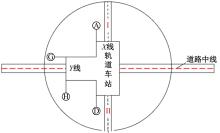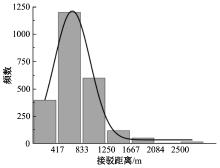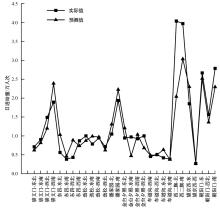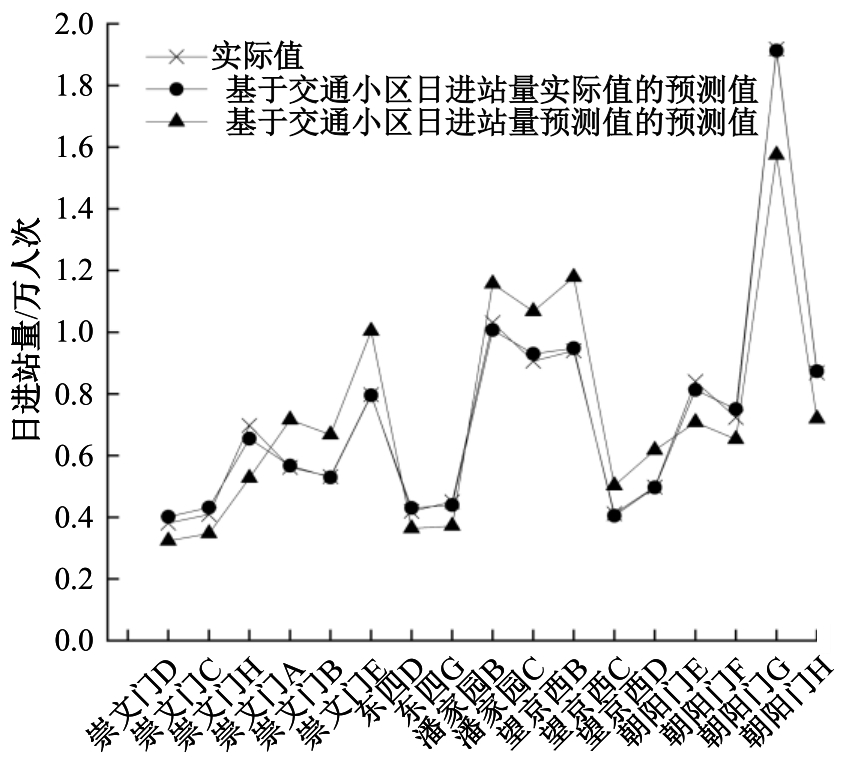Journal of Jilin University(Engineering and Technology Edition) ›› 2024, Vol. 54 ›› Issue (8): 2197-2205.doi: 10.13229/j.cnki.jdxbgxb.20221387
Previous Articles Next Articles
Passenger flow prediction at entrance and exit of rail transit stations:a case study of Beijing
Jie MA1,2( ),Zhi-li LIU1,Shu-ling WANG2,Hao DONG3
),Zhi-li LIU1,Shu-ling WANG2,Hao DONG3
- 1.School of Traffic and Transportation,Beijing Jiaotong University,Beijing 100044,China
2.Beijing Transport Institute,Beijing 100073,China
3.Beijing Public Transport Tram Corporation,Beijing 100080,China
CLC Number:
- U291.69
| 1 | Santos G, Maoh H, Potoglou D, et al. Factors influencing modal split of commuting journeys in medium-size European cities[J]. Journal of Transport Geography, 2013, 30: 127-137. |
| 2 | Wu J Y, Sun H J, Gao Z Y, et al. Risk‐based stochastic equilibrium assignment model in augmented urban railway network[J]. Journal of Advanced Transportation, 2014, 48(4): 332-347. |
| 3 | Wang J, Peeta S, He X, et al. Combined multinomial logit modal split and paired combinatorial logit traffic assignment model[J]. Transportmetrica A: Transport Science, 2018, 14(9): 737-760. |
| 4 | 王淑伟, 孙立山, 郝思源, 等. 基于精细化用地的轨道客流直接估计模型[J]. 交通运输系统工程与信息, 2015, 15(3): 37-43. |
| Wang Shu-wei, Sun Li-shan, Hao Si-yuan, et al. Station level transit ridership direct estimation model based on precise land use[J]. Journal of Transportation Systems Engineering and Information Technology, 2015, 15(3): 37-43. | |
| 5 | 岂常禄, 胡昊. 基于混合地理加权回归的城市轨道交通站点客流预测研究[J]. 铁道科学与工程学报, 2021, 18(7): 1903-1909. |
| Qi Chang-lu, Hu Hao. Research on ridership forecast of urban rail transit based on mixed geographic weighted regression[J]. Journal of Railway Science and Engineering, 2021, 18(7): 1903-1909. | |
| 6 | 何正强. 城市轨道交通车站分向客流预测方法研究[J]. 交通科技, 2012, 2012 (2): 119-122. |
| He Zheng-qiang. Study of prediction methods of passenger flow in different directions of urban rail transit station[J]. Transportation Science & Technology, 2012, 2012(2):119-122. | |
| 7 | 张哲宁, 程苑, 马毅林, 等. 城市轨道交通初步设计阶段接驳客流预测方法研究[J]. 交通工程, 2017, 17(3): 8-13. |
| Zhang Zhe-ning, Cheng Yuan, Ma Yi-lin, et al. The forecast method of urban rail transit passenger volume in the preliminary design phase[J]. Journal of Transportation Engineering, 2017, 17(3): 8-13. | |
| 8 | 傅搏峰, 吴娇蓉, 华陈睿. 轨道站出入口客流分布系数估计方法[J]. 同济大学学报: 自然科学版, 2012, 40(11): 1660-1665. |
| Fu Bo-feng, Wu Jiao-rong, Hua Chen-rui. Estimation method of distribution coefficient of passenger flow of subway station entrance[J]. Journal of Tongji University(Natural Science), 2012, 40(11): 1660-1665. | |
| 9 | Cervero R, Kockelman K. Travel demand and the 3Ds: density, diversity, and design[J]. Transportation Research Part D: Transport and Environment, 1997, 2(3): 199-219. |
| 10 | 李国强, 杨敏, 吴运腾, 等. 基于AFC和POI数据的轨道交通站点客流影响因素挖掘[C]//创新驱动与智慧发展——2018年中国城市交通规划年会论文集, 中国青岛, 2018: 1-11 . |
| Li Guo-qiang, Yang Min, Wu Yun-teng, et al. Research on influencing factors of passenger flow in rail transit stations based on AFC and POI data[C]//Innovation-driven and Intelligent Development -- Proceedings of the 2018 Annual Conference on Urban Transportation Planning in China, Qingdao, China, 2018: 1-11. | |
| 11 | 戴维佳. 轨道交通乘客全过程出行行为分析与站点客流吸引范围研究[D]. 北京: 北京交通大学交通运输学院, 2019. |
| Dai Wei-jia. Study on passengers´ full-process travel behavior and stations´ passenger flow attraction range for urban rail transit system[D]. Beijing: School of Traffic and Transportation, Beijing Jiaotong University, 2019. | |
| 12 | 王淑伟, 孙立山, 荣建. 北京市轨道站点吸引范围研究[J]. 交通运输系统工程与信息, 2013, 13(3): 183-188. |
| Wang Shu-wei, Sun Li-shan, Rong Jian. Catchment area analysis of Beijing transit stations[J]. Journal of Transportation Systems Engineering and Information Technology, 2013, 13(3): 183-188. | |
| 13 | 邓进. 城市轨道交通车站客流特征与周边土地利用互动关系[D]. 北京: 北京交通大学交通运输学院, 2015. |
| Deng Jin. Interactive relationship between ridership characteristics at subway station and surrounding land-use[D]. Beijing: School of Traffic and Transportation, Beijing Jiaotong University, 2015. | |
| 14 | 范琪, 王炜, 杨洋, 等. 家庭收入差异对出行方式选择的影响分析[J]. 交通信息与安全, 2019, 37(6): 111-120. |
| Fan Qi, Wang Wei, Yang Yang, et al. Effects of household income differences on travel mode choice[J]. Journal of Transport Information and Safety, 2019, 37(6): 111-120. | |
| 15 | 刘李红, 高辰颖, 王文超, 等. 京津冀高质量协同发展:演化历程、动力机理与未来展望[J]. 北京行政学院学报, 2023(5): 61-71. |
| Liu Li-hong, Gao Chen-ying, Wang Wen-chao, et al. High-quality coordinated development of the Beijing-Tianjin-Hebei region: evolution course, power mechanism and future prospects[J]. Journal of Beijing Administration Institute, 2023, 2023(5): 61-71. | |
| 16 | 邹江源, 叶霞飞. 城市轨道交通车站出入口布局规划方法[J]. 城市轨道交通研究, 2019, 22(12): 39-42. |
| Zou Jiang-yuan, Ye Xia-fei. Layout of station entrance and exit for urban rail transit[J]. Urban Mass Transit, 2019, 22(12): 39-42. | |
| 17 | 薛薇. SPSS统计分析方法及应用[M]. 北京: 电子工业出版社, 2009. |
| [1] | Ying REN,Jian-hua DUO,Rui-xia SONG. Design of rail transit signal joint control system based on variable structure PID control [J]. Journal of Jilin University(Engineering and Technology Edition), 2024, 54(8): 2364-2369. |
| [2] | Bo-song FAN,Chun-fu SHAO. Urban rail transit emergency risk level identification method [J]. Journal of Jilin University(Engineering and Technology Edition), 2024, 54(2): 427-435. |
| [3] | Jing WANG,Feng WAN,Chun-jiao DONG,Chun-fu SHAO. Modelling on catchment area and attraction intensity of urban rail transit stations [J]. Journal of Jilin University(Engineering and Technology Edition), 2023, 53(2): 439-447. |
| [4] | Min MA,Da-wei HU,Lan SHU,Zhuang-lin MA. Resilience assessment and recovery strategy on urban rail transit network [J]. Journal of Jilin University(Engineering and Technology Edition), 2023, 53(2): 396-404. |
| [5] | Qing-yong WANG,Wei-qiang QU. Optimization algorithm of urban rail transit operation scheduling based on linear programming [J]. Journal of Jilin University(Engineering and Technology Edition), 2023, 53(12): 3446-3451. |
| [6] | Lin JIANG,Ling ZHOU,Hui ZHAO. Design and stiffness continuously adjustable analysis of hydraulic servo flexible drive mechanism [J]. Journal of Jilin University(Engineering and Technology Edition), 2022, 52(7): 1499-1508. |
| [7] | Ting-ping ZHANG,Di WAN. Evaluation algorithm of rail transit node importance based on rough set theory [J]. Journal of Jilin University(Engineering and Technology Edition), 2022, 52(12): 2845-2851. |
| [8] | Feng XUE,Chuan-lei HE,Qian HUANG,Jian LUO. Coordination degree of multimodal rail transit network [J]. Journal of Jilin University(Engineering and Technology Edition), 2021, 51(6): 2040-2050. |
| [9] | Cai-hua ZHU,Xiao-li SUN,Yan LI. Forecast of urban public bicycle traffic demand by station classification [J]. Journal of Jilin University(Engineering and Technology Edition), 2021, 51(2): 531-540. |
| [10] | ZHAO Xue-yu, YANG Jia-qi, PENG Ya-mei. Competitive and cooperative relationship evolution mechanism between urban rail transit and traditional bus [J]. 吉林大学学报(工学版), 2017, 47(3): 756-764. |
| [11] | YAO Xiang-ming, ZHAO Peng, YU Dan-dan. Dynamic origin-destination matrix estimation for urban rail transit based on averaging strategy [J]. 吉林大学学报(工学版), 2016, 46(1): 92-99. |
| [12] | CAO Yang, ZHAO Shu-zhi, TIAN Qing-fei. Urban rail transit subsidy policy based on maximum welfare [J]. , 2012, (03): 618-622. |
| [13] | ZHAO Shu-zhi, CAO Yang, TIAN Qing-fei. Urban rail transit scheduling decision based on information fusion [J]. 吉林大学学报(工学版), 2011, 41(增刊1): 85-88. |
| [14] | CHEN Peng|YAN Xin-ping|LI Xu-hong|WU Chao-zhong. Schedule coordination model between rail transit and bus transit [J]. 吉林大学学报(工学版), 2011, 41(4): 950-955. |
| [15] | XU Wang-tu,HE Shi-wei,SONG Rui. Headway and fare optimization model for feeder bus of rail transit [J]. 吉林大学学报(工学版), 2009, 39(06): 1469-1474. |
|









